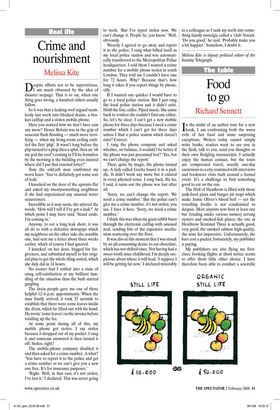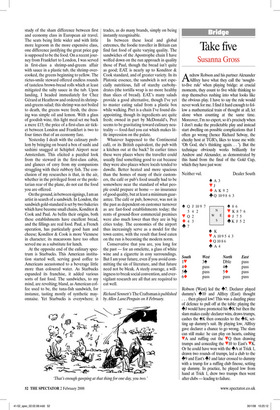Food to go
Richard Sennett
In the midst of an author tour for a new book, I am confronting both the worst evils of fast food and some surprising exceptions. Writers today cannot simply write books; readers want to see you in the flesh, talk to you, send you thoughts or their own fledgling manuscripts. I actually enjoy the human contact, but the tours are compressed travel, usually one-day excursions to a city crammed with interviews and bookstore visits built around a formal event. It’s a challenge to find something good to eat on the run.
The Hell of Heathrow is filled with those junk-food pizza and burger pit stops which make Jamie Oliver’s blood boil — yet the travelling foodie is not condemned to despair. Most airports now host at least one bar (trading under various names) serving oysters and smoked-fish plates; the one at Heathrow Terminal Three is actually good, very good, the smoked salmon high-quality, the wine list impressive. Unfortunately, the bars cost a packet; fortunately, my publisher is paying.
My publishers are also flying me firstclass; booking flights at short notice seems to offer them little other choice. I have therefore been able to conduct a scientific study of the sham difference between first and economy class in European air travel. The seats being little wider and with little more legroom in the more expensive class, one difference justifying the great price gap is supposed to be the food. On a recent journey from Frankfurt to London, I was served in first-class a shrimp-and-greens affair with sauce in a plastic tub, the shrimp overcooked, the greens beginning to yellow. The rictus-smile steward offered endless rounds of tasteless brown-bread rolls which at least mitigated the salty sauce in the tub. Upon landing, I headed immediately for Chez Gérard at Heathrow and ordered its shrimpand-greens salad; this shrimp was not boiled to death, the greens were fresh, the dressing was simple oil and lemon. With a glass of goodish wine, this light meal set me back a mere £15; the price of a first-class air ticket between London and Frankfurt is two to four times that of an economy fare.
Yesterday I dealt with the culinary problem by bringing on board a box of sushi and sashimi snagged at Schiphol Airport near Amsterdam. This elicited a puzzled look from the steward in the first-class cabin, and glances of envy from my companions struggling with their rubbery fish. The conclusion of my researches is that, in the air, whether in the privileged front or the proletarian rear of the plane, do not eat the food you are offered.
On the ground, in between signings, I am an artist in search of a sandwich. In London, the sandwich gold-standard is set by two bakeries which have become small chains, Konditor & Cook and Paul. As befits their origins, both these establishments have excellent bread, and the fillings are real food. Paul, a French operation, has particularly good ham and cheese; Konditor & Cook is more Viennese in character; its macaroons have too often served me as a substitute for lunch.
At the opposite end of the culinary spectrum is Starbucks. This American institution started well, serving good coffee to Americans accustomed to a beverage little more than coloured water. As Starbucks expanded its franchise, it added various sorts of fast food. The sandwiches, to my mind, are revolting; bland, as American coffee used to be, the tuna-fish sandwich, for instance, tasting mostly of synthetic mayonnaise. Yet Starbucks is everywhere; it trades, as do many brands, simply on being instantly recognisable.
In between these local and global extremes, the foodie traveller in Britain can find fast food of quite varying quality. The sandwiches of the Apostrophe chain I have wolfed down on the run approach in quality those of Paul, though the bread isn’t quite as good; EAT. is nearly up to Konditor & Cook standard, and of greater variety. In its Platonic essence, the sandwich is not especially nutritious, full of starchy carbohydrates (the tortilla wrap is no more healthy than slices of bread). EAT.’s many salads provide a good alternative, though I’ve yet to master eating salad from a plastic box while walking. Pret is a chain I’ve found disappointing, though its ingredients are quite fresh; owned in part by McDonald’s, Pret seems to be gravitating toward culinary neutrality — food-fuel you eat which makes little impression on the palate.
Whatever happened to the Continental café, or its British equivalent, the pub with a kitchen out at the back? In earlier times these were places where the traveller could usually find something good to eat because they were also places where locals tended to dawdle. Better heated and more spacious than the homes of many of their customers, the café or pub’s food usually had to be somewhere near the standard of what people could prepare at home — no insurance of good quality, but at least a minimum guarantee. The café or pub, however, was not in the past as dependent on customer turnover as are fast-food establishments today; the rents of ground-floor commercial premises were also much lower than they are in big cities today. The economics of the airport thus increasingly serve as a model for the town centre, with the result that food eaten on the run is becoming the modern norm.
Conservative that you are, you long for the past — for an omelette, a glass of white wine and a cigarette in cosy surroundings. But I am your future, even if you avoid committing the sin of literature, and that future need not be bleak. A steely courage, a willingness to break social convention, and evervigilant research are all that are required to eat well.
Richard Sennett’s The Craftsman is published by Allen Lane/Penguin on 8 February.



































































 Previous page
Previous page